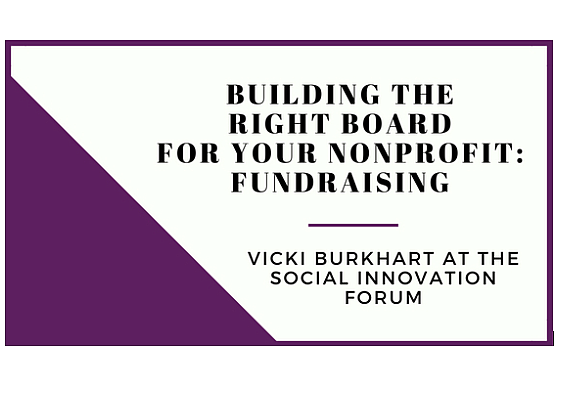
On August 14, the Social Innovation Forum hosted the fourth session in our board development series with Vicki Burkhart of the Burkhart Group at More Than Giving Co. The first three workshops focused on How to Build the Right Board for Organizational Growth; Building Board Culture & Strategies for Dealing with Challenging Board Members; and Leadership and Succession Planning, Officer/Committee Training, and Strategic Planning. The fourth session in the series was Building the Right Board for your Nonprofit: Fundraising, where we discussed how we can engage everyone on the board in the fundraising process and the strategies needed to build a fundraising board.
The workshop included nonprofit leaders and board members from SIF’s alumni portfolio, Social Innovator Accelerator finalists, and coworking members. Here are some key takeaways:
Set Realistic Expectations
Vicki reminded us that one of the key responsibilities of a nonprofit board is to ensure that the organization has enough resources to fulfill its mission. That said, no matter whether you’re recruiting a board member for their skills, experience, or broader fundraising ability, it is important to be straightforward about fundraising responsibilities during the recruitment process. The open discussion of fundraising responsibilities in the early stages of recruitment ensures that board members know the expectations. If a potential board member is not prepared to take the steps necessary to be a fundraising board member, then they may not be a good fit for the board.
Beyond making expectations clear in the board recruitment process, board members need to continue to be held accountable throughout their board tenure. There are several strategies to accomplish accountability, including:
- Resending the board position description every year to remind board members of what they are committed to in their position as a board member.
- Requiring the signing of a board contract or board expectation statement so board members have a tangible commitment to fundraising.
- Placing fundraising on each board meeting agenda to ensure that board members understand the importance of fundraising in their role.
Encourage Ownership
Another method of engaging board members in the fundraising process is to encourage the ownership of the fundraising process. This can be accomplished by having the board’s approval of the organization’s budget set the tone for income generation. If the board approves the budget, the board, in partnership with the staff team, has to do their part to reach budget goals. Remember: the board is critical for successful fundraising and should be willing to cultivate and steward gifts within his or her networks at whatever level is meaningful for them. Engaging board members in fundraising strategy will lead to more ownership of the initiatives.
Involve them in the Fundraising Process
After the ownership of the fundraising process comes involvement. Involvement in the fundraising process comes in two forms.
- As Fundraising Donors, board members’ involvement goes beyond simple donations. While making appropriate personal gifts, board members can also serve as a role model for those outside of the organization and on the board. Showing their support financially shows others the breadth and depth of their support and involvement in the organization, while also serving as a good example for other board members who will, hopefully, follow suit. They can also engage their employers to support the organization by utilizing matching programs or employee giving programs. Not all board members need to contribute at the same level, but you should feel comfortable asking board members to contribute what is personally meaningful for them and perhaps ask for your organization to be at the top of giving while they serve as a board member.
- As Fundraising Team Members, board members become integrated into the fundraising process. Board members can provide invaluable help to the organization in this role by participating on a fundraising or event committee. They can also complete thank you notes and calls or participate in donor visits. These actions indicate commitment to the organization, and potential donors want to meet with committed leadership.
Provide the Necessary Tools
Nonprofit leaders often need to give board members tools to make certain that fundraising will be prioritized. The goal of providing these tools is to connect prospective donors to the organization. For example, drafting LinkedIn or Facebook posts that can be posted by board members provides access to professional and personal networks. These posts ensure that people know that board members are a part of the organization and can be used to generate interest in your organization and expand its network.
To learn more about board development or to set up a training at your organization, contact Vicki Burkhart of The Burkhart Group at vsb@burkhartgroup.com.
 Social Innovation Forum
Social Innovation Forum